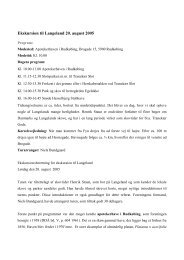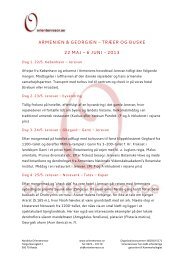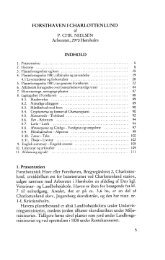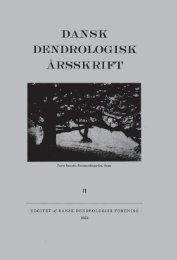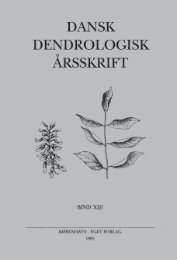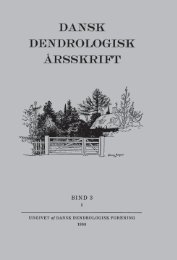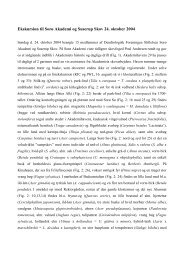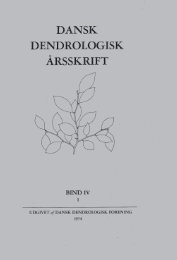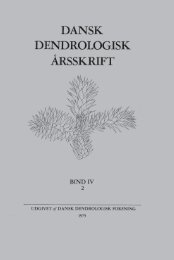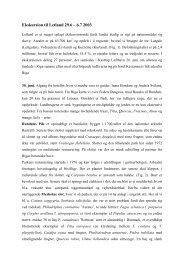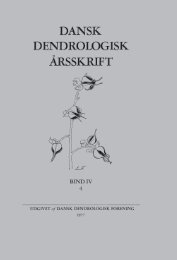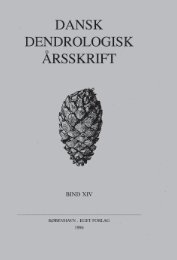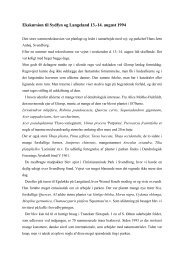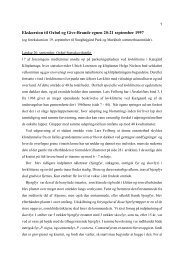Volume 2,1 (1963) - Dansk Dendrologisk Forening
Volume 2,1 (1963) - Dansk Dendrologisk Forening
Volume 2,1 (1963) - Dansk Dendrologisk Forening
Create successful ePaper yourself
Turn your PDF publications into a flip-book with our unique Google optimized e-Paper software.
Pinus contorta, Shore Pine or Shrub Pine is a little tree with broad<br />
limbs and dark needles; the bark soon gets thick and scaly, the cones<br />
are a little oblique with rather thin conescales and shields. Only very<br />
few specimens are closepines. It is found in the coastal zone from<br />
Alaska to California growing on poor and dry soil often shrubby but<br />
sometimes a rather nice shape. Here in Denmark it is much affected<br />
by damage from Tortrix buoliana.<br />
Pinus c. latifolia, Lodgepole Pine, Murrayana Pine, is a slender<br />
tree with small and fine limbs. The bark remains for a long time<br />
rather smooth, with a very characteristic surface due to the resinblisters<br />
giving in the aspect of that of a Cherry-tree with lenticels.<br />
When the bark finally gets crustaceous it is much thinner than the<br />
bark of the first variety which although it has got the species-name<br />
without any suffixes is the less important type compared with lati folia<br />
which covers large areas. The cones are very oblique and the conescales<br />
on the outer side of the cone are thick, with a very thick<br />
shield often characterized by a protruded and reflexed umbo. A<br />
rather large number of the trees in a stand are closepines, the cones<br />
remaining closed for years and the seeds not spread until the cones<br />
open after a forest-fire. It grows inland from the Cascades to the<br />
Rockies forming large, very dense pure stands presumably owing<br />
their existence to forest-fires. These stands are found on rather good<br />
soil but on extreme localities: near timberline, on bogs or on sandy<br />
fields in the dry interior types reminding in shape and sometimes in<br />
a few characters too of the Shore Pine. It must be added that on<br />
the westfall of the Cascades quite intermediate forms were met with.<br />
Here in Denmark it often thrives rather well and is never affected by<br />
the Tortrix. The Americans do not venture to distinguish these two<br />
forms as species and call them as a whole Lodgepole Pine or even<br />
Jack Pine, which is the name for P. Banksiana. But I must admit,<br />
that I find them better distinguished than the types of the Douglas<br />
fir at least the viridis and the caesia types.<br />
3. Pinus ponderosa Laws, and P. Jeffrey i A. Murr. represents two<br />
well defined species, which differ in several characters and partly<br />
in distribution but where they meet they are said to be so mixed in<br />
characters, that it is impossible to check them out in the stands. I<br />
regret, that I have not seen this transition-zone and have only got a<br />
personal impression of ponderosa in the northern part of its area.<br />
Pinus ponderosa, has bark reminding of that of a P. nigra but the furrows<br />
are of a bright orange red to orange yellow colour. The needles<br />
vary in length, but are mostly more than 20 cm long, in colour they



